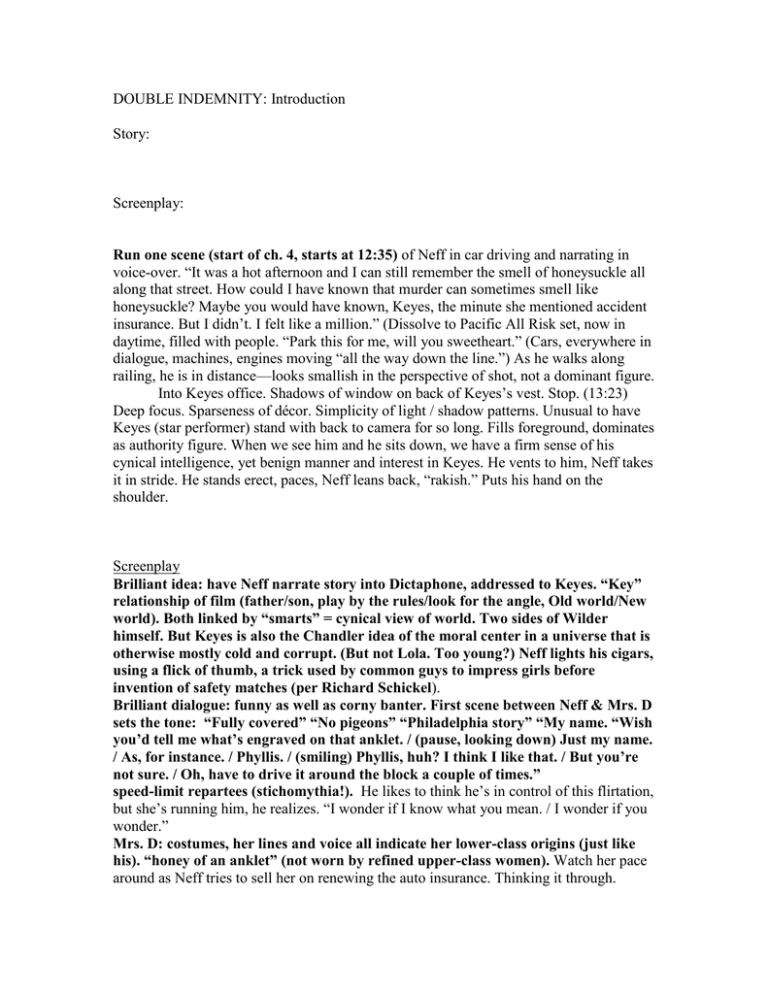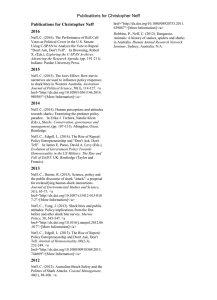
DOUBLE INDEMNITY: Introduction
Story:
Screenplay:
Run one scene (start of ch. 4, starts at 12:35) of Neff in car driving and narrating in
voice-over. ―It was a hot afternoon and I can still remember the smell of honeysuckle all
along that street. How could I have known that murder can sometimes smell like
honeysuckle? Maybe you would have known, Keyes, the minute she mentioned accident
insurance. But I didn’t. I felt like a million.‖ (Dissolve to Pacific All Risk set, now in
daytime, filled with people. ―Park this for me, will you sweetheart.‖ (Cars, everywhere in
dialogue, machines, engines moving ―all the way down the line.‖) As he walks along
railing, he is in distance—looks smallish in the perspective of shot, not a dominant figure.
Into Keyes office. Shadows of window on back of Keyes’s vest. Stop. (13:23)
Deep focus. Sparseness of décor. Simplicity of light / shadow patterns. Unusual to have
Keyes (star performer) stand with back to camera for so long. Fills foreground, dominates
as authority figure. When we see him and he sits down, we have a firm sense of his
cynical intelligence, yet benign manner and interest in Keyes. He vents to him, Neff takes
it in stride. He stands erect, paces, Neff leans back, ―rakish.‖ Puts his hand on the
shoulder.
Screenplay
Brilliant idea: have Neff narrate story into Dictaphone, addressed to Keyes. “Key”
relationship of film (father/son, play by the rules/look for the angle, Old world/New
world). Both linked by “smarts” = cynical view of world. Two sides of Wilder
himself. But Keyes is also the Chandler idea of the moral center in a universe that is
otherwise mostly cold and corrupt. (But not Lola. Too young?) Neff lights his cigars,
using a flick of thumb, a trick used by common guys to impress girls before
invention of safety matches (per Richard Schickel).
Brilliant dialogue: funny as well as corny banter. First scene between Neff & Mrs. D
sets the tone: “Fully covered” “No pigeons” “Philadelphia story” “My name. “Wish
you’d tell me what’s engraved on that anklet. / (pause, looking down) Just my name.
/ As, for instance. / Phyllis. / (smiling) Phyllis, huh? I think I like that. / But you’re
not sure. / Oh, have to drive it around the block a couple of times.”
speed-limit repartees (stichomythia!). He likes to think he’s in control of this flirtation,
but she’s running him, he realizes. ―I wonder if I know what you mean. / I wonder if you
wonder.‖
Mrs. D: costumes, her lines and voice all indicate her lower-class origins (just like
his). “honey of an anklet” (not worn by refined upper-class women). Watch her pace
around as Neff tries to sell her on renewing the auto insurance. Thinking it through.
The three leads were all cast somewhat against type, and it made their
performances both interesting at the time and somehow still convincing. MacMurray’s
comic lightweight qualities make him effectively harsh yet lighweight. Stanwyck ―lady of
burlesque‖ (Ball of Fire year before = ―snow white‖ as femme fatale in middle of 7
dwarfs!)
Wilder as director: superb with bit players as well as leads.
Elevator operator: you really believe that’s who he is! (Great line about why ―they‖ won’t
sell him any insurance: ―Something loose in my heart. Hah-hah. I say it’s rheumatism.‖)
Netty (house maid). Small, but thick and tough, like a watch-dog. One good zinger: ―we
keep the liquor cabinet locked up.‖
Sets
Pacific All-Risk Insurance (novel: ―General Fidelity‖!). Balcony looks down on rows
upon rows of ordinary desks (no partitions), cleaning help. Neff moves along balcony
railing (cf. first shot of Mrs. Dietrichsen).
Dietrichsen house: ―one of those California Spanish houses everyone was nuts about
about ten or fifteen years ago. … This one must have cost somebody about thirty
thousand bucks—that is, if he ever finished paying for it.‖ Inside—main room, filled with
things, but little personality. (Cf. his apartment.) Just emptiness, light, shadow, and dust.
(Cameraman used aluminum filings to create haze). Venetian blinds give texture to
lighting—complicated criss-cross patterns, depths (as in railings of All-Risk).
Locations
First is Los Angeles street—empty! (no cars)—workmen at night, car racing towards
camera (picks up idea of moving toward camera from opening credits). / C.U. stop traffic
signal: car rushes through ―Stop‖ sign, near accident. / Exterior office building (= first
set.)
Second is view of LA from hillside road. Lots of haze in background. 3 kids playing
stickball in street. (Sense of family/friends/American traditional.)
Run second clip, but without sound.
Drive –in / bowling alley (quick shots). Darkness of his apartment. One source of light
(window) with shadows of rain streaking. He paces irresolute. Hears something, goes to
door, opens it, and there she is. Only one main light source. When she comes in she steps
into his darkness.
Quotes © Paramount Pictures, Inc. All rights reserved. This content is excluded from our
Creative Commons license. For more information, see http://ocw.mit.edu/fairuse.
MIT OpenCourseWare
http://ocw.mit.edu
CMS.S61 Special Subject: The Rise of Film Noir
January IAP 2012
For information about citing these materials or our Terms of Use, visit: http://ocw.mit.edu/terms.


